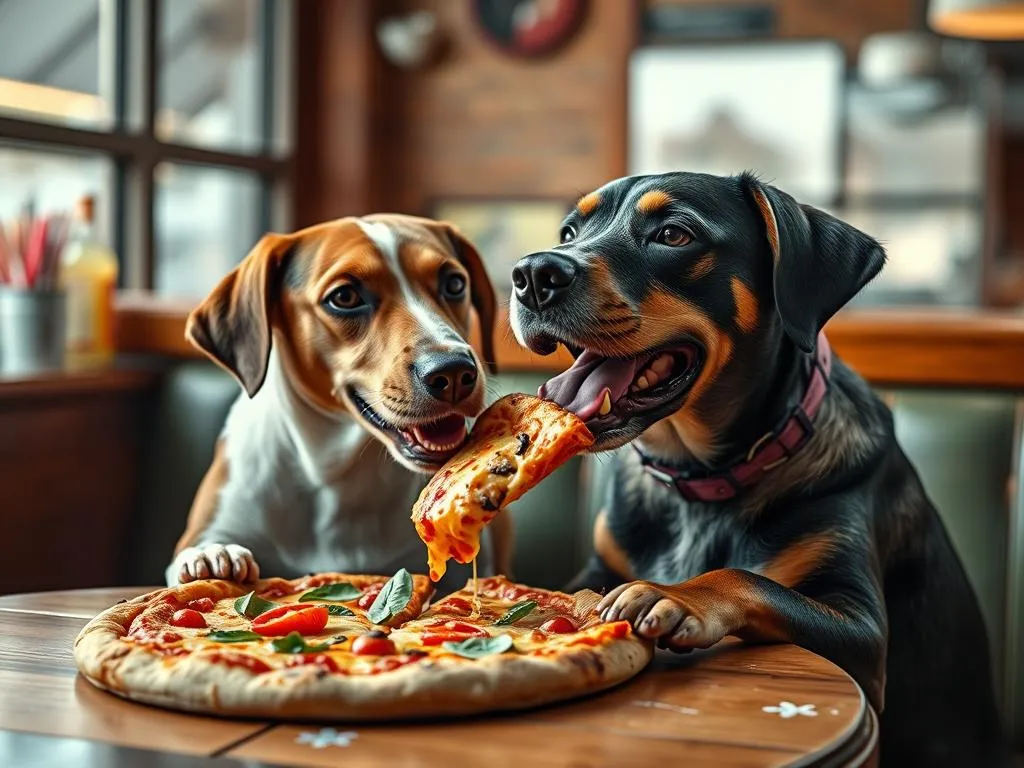
Understanding dog nutrition is essential for ensuring our furry friends lead happy and healthy lives. As dog owners, we often wonder which human foods are safe to share with our pets. One common question that arises is, “Can dogs eat pizza?” This question highlights the importance of recognizing which human foods can be beneficial or harmful to our dogs.
Understanding Dog Nutrition
Basic Nutritional Needs of Dogs
Dogs, like humans, require a balanced diet to thrive. Their nutritional needs can be broken down into macronutrients and micronutrients:
- Proteins: Essential for growth, repair, and overall health. Dogs need high-quality protein sources to maintain muscle mass and support immune function.
- Fats: Provide energy, support cell structure, and help absorb certain vitamins. Healthy fats, such as omega-3 and omega-6 fatty acids, are particularly important.
- Carbohydrates: While not as crucial as proteins and fats, carbohydrates offer a quick energy source and can aid digestion.
In addition to macronutrients, dogs also need micronutrients like vitamins and minerals to support bodily functions. Furthermore, water is vital and should always be available to keep dogs hydrated.
Common Ingredients in Dog Food
Dog food comes in various forms, including dry kibble, wet food, and raw diets. When selecting dog food, it’s essential to look for high-quality ingredients:
- Meat or meat meal as the first ingredient
- Whole grains or vegetables for carbohydrates
- Healthy fats from sources like fish oil
A balanced diet ensures dogs receive the necessary nutrients for optimal health, keeping their fur shiny and their energy levels high.
Human Foods and Dogs
Safe Human Foods for Dogs
Many human foods can be safely shared with dogs, enhancing their diets with additional nutrients. Some common safe foods include:
- Cooked chicken or turkey: Great protein source
- Carrots: Low-calorie snack rich in vitamins
- Peanut butter: A favorite treat (ensure it’s xylitol-free)
- Pumpkin: Excellent for digestion
Sharing these foods can benefit dogs, providing variety and additional nutrients when given in moderation.
Foods to Avoid
Not all human foods are safe for dogs. Some toxic foods include:
- Chocolate: Can cause severe health issues
- Grapes and raisins: Can lead to kidney failure
- Onions and garlic: Harmful to red blood cells
Feeding dogs inappropriate human foods can pose significant risks, leading to health complications and even emergencies.
The Pizza Dilemma
What Is Pizza Made Of?
Pizza is a beloved dish made from various ingredients, typically including:
- Dough: The base of the pizza
- Tomato sauce: A flavorful topping
- Cheese: A rich, creamy layer
- Toppings: Varied, from meats to vegetables
Each of these components has different nutritional aspects, which can impact a dog’s health.
Can Dogs Eat Pizza?
Examining each ingredient in pizza helps answer the question of whether dogs can safely consume it:
-
Dough: While plain dough may not be toxic, it can cause digestive issues. Rising dough can expand in a dog’s stomach, leading to discomfort or even serious complications.
-
Tomato Sauce: Many sauces contain garlic or onion, which are harmful to dogs. Even plain tomato sauce can be high in sugar and salt, not ideal for canine diets.
-
Cheese: While cheese is a source of protein and calcium, many dogs are lactose intolerant. This can lead to gastrointestinal upset if consumed in large amounts.
-
Toppings: Some toppings, like pepperoni, are high in fat and sodium, which can contribute to obesity and pancreatitis. Vegetables like bell peppers and mushrooms can be safe, but caution is advised with others.
Potential Risks of Feeding Dogs Pizza
Feeding dogs pizza can lead to several health concerns:
- Digestive issues: Dogs may experience diarrhea, vomiting, or bloating after consuming rich, fatty foods like pizza.
- Allergic reactions: Some dogs may be allergic to ingredients found in pizza, leading to skin irritations or gastrointestinal distress.
- Long-term health implications: Regularly feeding pizza can contribute to obesity, pancreatitis, and other health issues due to high fat and sodium content.
Alternatives to Pizza for Dogs
Dog-Safe Pizza Recipes
If your dog loves the taste of pizza, consider making a dog-friendly version at home. Here’s a simple recipe:
Dog-Friendly Pizza Recipe:
- Ingredients:
- 1 cup whole wheat flour
- 1/2 cup rolled oats
- 1/4 cup low-sodium chicken broth
- 1/4 cup shredded low-fat cheese
-
Toppings: cooked chicken, bell peppers, or carrots
-
Instructions:
- Preheat the oven to 350°F (175°C).
- Mix the flour, oats, and chicken broth to form a dough.
- Roll out the dough and place it on a baking sheet.
- Sprinkle cheese and add dog-safe toppings.
- Bake for 15-20 minutes until golden brown.
This alternative provides a safe way to treat your dog without the harmful ingredients found in traditional pizza.
Other Treats for Dogs
In addition to homemade pizza, there are many nutritious treats that can be given to dogs:
- Carrot sticks: Crunchy and low in calories
- Apple slices: Great source of vitamins (remove seeds)
- Peanut butter-filled toys: Keeps dogs entertained and happy
Moderation is key when providing treats, ensuring they complement a balanced diet.
Expert Opinions and Studies
Veterinarian Insights on Human Foods
Veterinarians often emphasize the importance of understanding which human foods are safe for dogs. Many recommend avoiding highly processed foods, including pizza, due to their high fat, sugar, and salt content. Research indicates that a balanced diet tailored to a dog’s specific needs is crucial for long-term health.
Dog Nutrition Trends
In the ever-evolving field of dog nutrition, trends like grain-free diets and raw food diets have gained popularity. These trends influence how pet owners perceive human food, often leading to confusion about what is safe to share with their pets. It’s essential to remain informed and consult with a veterinarian when considering new diet trends for dogs.
Conclusion
In summary, while the question, “Can dogs eat pizza?” may seem straightforward, the answer is nuanced. The ingredients in pizza can pose various risks to dogs, from digestive issues to long-term health complications. Understanding dog nutrition and the impacts of human food on their health is vital for responsible pet ownership.
Pet owners should always consult with veterinarians regarding their dog’s diet and consider safe, nutritious alternatives to human foods like pizza.
FAQs
Can dogs eat pizza crust?
While plain pizza crust is not toxic, it can lead to digestive issues. It’s best to avoid giving crust to dogs.
What if my dog accidentally eats pizza?
If your dog accidentally consumes pizza, monitor them for signs of distress. If they exhibit vomiting, diarrhea, or lethargy, contact your veterinarian.
Are there any pizza toppings that are safe for dogs?
Certain toppings like cooked chicken, bell peppers, or carrots can be safe for dogs. However, avoid high-fat meats and toppings that might contain harmful ingredients like onions or garlic.
How often can I share human food with my dog?
Human food should only be shared in moderation. Treats should not exceed 10% of your dog’s daily calorie intake, and it’s essential to choose safe options.









